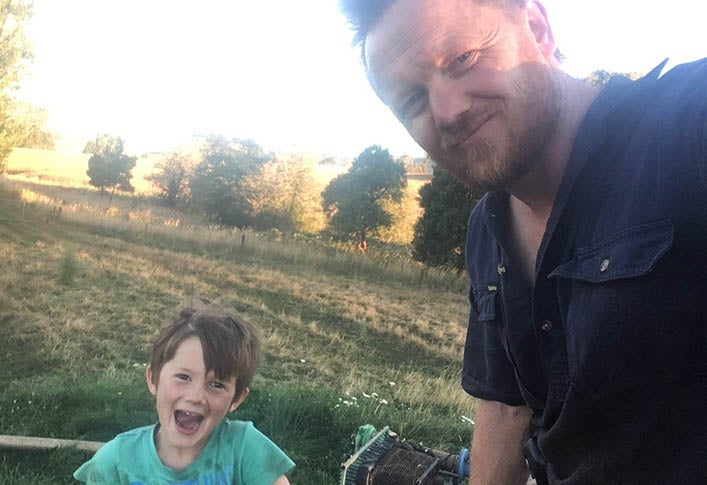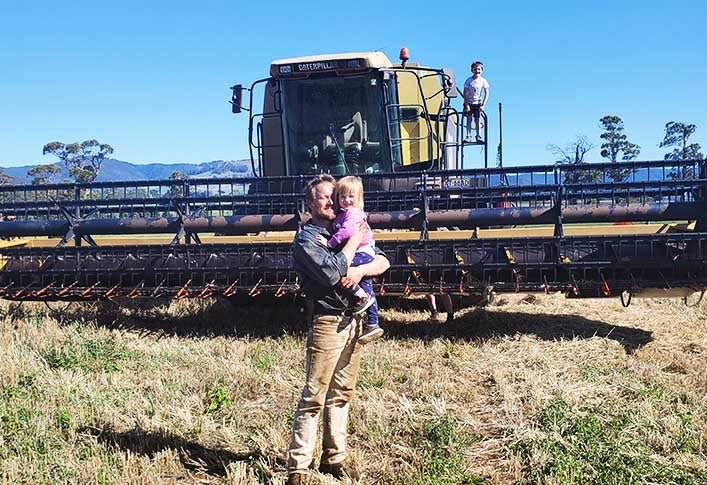Posted by on
16/04/2021
Life is gradually re-emerging on Michael Heyes’ Tasmanian farming operation – above ground and below.
Running 385 hectares in the Ringarooma region, Michael, together with brother Richard and father Peter, manage 180 Angus breeders, pastures and cereal crops including wheat and barley, and output 3000 tonnes of potatoes annually on their own farm, plus on another leased 100 hectares.
Growing concerns around chemical usage on the farm – its degradation of soil health, ecosystems, cost, and impact on their own personal health – prompted the family to gradually reduce artificial fertilisers and chemicals over recent years, with the Heyes family now only using synthetic fertilisers in the growing of potatoes, but at reduced rates, and using products more gentle on soil life.
The Heyes family is part of a growing trend of producers, looking to nature and traditional methods to ensure Australian households have a growing choice when looking to source genuine chemical-free produce options.
“My philosophy has always been to sell a product that I believe in, that is good for people, good for animals and good for the environment, and I just couldn’t reconcile the role of chemical use in that reasoning,” Michael said.
A number of crops traditionally grown on the farm are no longer viable due to their chemical needs, with cover crops grown to stifle weeds, and a fish, kelp and molasses mix used to feed soil biology.
But he admits going chemical free had not been easy, with very little funding and research available to guide the process – prompting Michael to take the gantlet as a self-appointed guinea pig.
“People probably say I experiment too much, but we’re willing to try anything if there’s a chance we can increase yields without compromising the natural balance of the surrounding environment.”
Multi-species cover crops are one innovation the family has adopted, aimed at helping increase soil biodiversity, as well as animal health.
What started as three to four species mix in one paddock has now expanded to up to 10 species grown simultaneously.
“The more species you grow the greater the soil biological diversity,” Michael explained. “As each plant expands it releases different sugars into the soil, so the diversity of species means there’s also a healthy variation of nutrients being returned to the earth.”
The same was true for animal health, he said.
“The greater the range of plant species being eaten by grazing cattle, the more diverse the gut biology is within the stock, and gut health is catalyst for a healthy beast.”
Grazing cattle on pasture had also been an evolving process in recent years, at one stage the family ceased grazing cover crops due to the cattle’s feared compaction on the soil, however after much research the operation has reached a happy medium.
“We now are interested and experimenting with the mob grazing technique, rotating our grazing cattle frequently so the soil benefits from ruminant returns improving organic matter and biological activity, with minimal soil disruption due to the short duration of grazing.”
Michael said the soil was in far better condition since the adoption of multi-species cover crops and reduced chemicals and fertilisers, with worms abundant across the property.
Improving yields had, however, remained a challenge.

“While we have lowered our costs, many of these crops were bred for use with chemicals, so they don’t respond well without them,” he said. “Our next step is to look back in history at some of the ancient varieties that respond much better to traditional ways.”
Michael mixes his own nutrient dense brew of fish, kelp molasses and humates, which he applies two to three times a year, and said while he was happy with his pasture growth and soil structure, the holy grail was to improve cropping yields without synthetic inputs.
“I’ve read about it in the US where they’ve been able to achieve a soil biology that is so healthy and diverse that yields have been quite high, and that’s our aim.”
Michael retains his cover crops for up to 18 months, grazing off one half to two thirds before letting plants re-grow.
“I don’t think eating everything to the ground is sustainable in the long run – some may think we’re mad growing these massive cover crops without grazing them off, but in our view they more than serve their purpose.”
Last summer, the Heyes’ grew a crop featuring a number of flowering species such as sunflowers and buckwheat to attract beneficial insects to the farm.
“I know there were people who just couldn’t get their head around the fact we weren’t grazing it down, but that was never the intention, we wanted to feed our soil.”
Weeds were proving a further challenge in the Heyes’ regenerative quest, however cover crops to smother growth were helping mitigate the problem.
And always thinking outside the box, Michael is currently toying with the idea of letting the weeds strike, and grazing them before they set seed.
He also recently ‘made up’ a multi-species crop combination of lupins and barley, based on the theory that – as a legume – nitrogen from the lupin would benefit the barley growth.
“I was trying to replicate a peas and oats cover crop, and it was successful in so far as it worked, however it didn’t yield as I had hoped, next time I need to add more lupins,” he said.
However, having inoculated and fixed nitrogen heavily, Michael is keen to see how his next crop in that paddock performs.
Michael is also experimenting with his current potato crop, planting an area without any organic fertiliser, and another area where mycorrhizal fungi was sprayed on the seed, and again no fertiliser applied, all in the name of yield comparison.
After 18 months of a continual cover crop over the potato fields, planting preparation followed a minimum-till strategy, with a light disk applied to work the top and the paddock ripped twice before seeding.

“We don’t seem to have lost yield using this technique, but we’ve cut our costs enormously, and the soil is all the better for it too,” Michael said.
A client of Rabobank for over ten years, Michael said it was the agricultural nature of the bank that first proved appealing.
“We’re an agricultural business, and as agricultural specialists Rabobank was a natural choice,” Michael said. “And over the years I have enjoyed visits from our bank managers, which I’m sure not everyone can admit to,” he laughed.
He said his manager Helene Gunn had proved a further breath of fresh air, her interest and engagement in their operation clearly genuine.
“Seeing Helene so enthusiastic towards our ideas is so encouraging, and we’re so reassured having her on this journey with us.”
Rather than become scapegoats for climate change, Michael believed farmers were perfectly placed to take a lead in the environmental debate.
“Through changing methods we have enormous capacity to sequester carbon in the soil, and help correct and encourage biodiversity.”
Already, Michael has spotted five frogs sitting in the middle of a spud paddock, a scene unheard of until now, and while the sight of grubs on his spuds incited some fear, the crows have naturally mitigated much of the problem.
“When you just leave things be it’s amazing what mother nature can come up with.”
